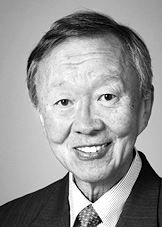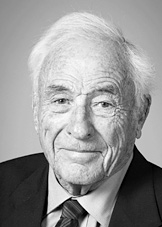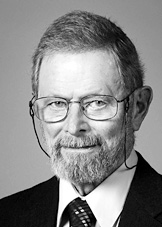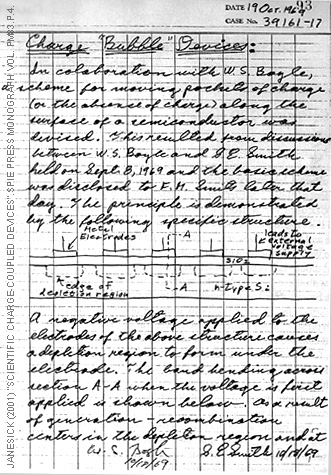C reative
Particle
Higgs
CPH Theory is based on Generalized light velocity from energy into mass.
CPH Theory in Journals
|
Nobel 2009
|
|||||||||||
|
The Nobel Prize in Physics 2009 was divided, one half awarded to Charles Kuen Kao "for groundbreaking achievements concerning the transmission of light in fibers for optical communication", the other half jointly to Willard S. Boyle and George E. Smith "for the invention of an imaging semiconductor circuit - the CCD sensor". The Royal Swedish Academy of Sciences has decided to award the Nobel Prize in Physics for 2009 with one half to
Charles K. Kao "for groundbreaking achievements concerning the transmission of light in fibers for optical communication" and the other half jointly to
Willard S. Boyle and George E. Smith "for the invention of an imaging semiconductor circuit – the CCD sensor" The masters of lightThis year's Nobel Prize in Physics is awarded for two scientific achievements that have helped to shape the foundations of today’s networked societies. They have created many practical innovations for everyday life and provided new tools for scientific exploration. In 1966, Charles K. Kao made a discovery that led to a breakthrough in fiber optics. He carefully calculated how to transmit light over long distances via optical glass fibers. With a fiber of purest glass it would be possible to transmit light signals over 100 kilometers, compared to only 20 meters for the fibers available in the 1960s. Kao's enthusiasm inspired other researchers to share his vision of the future potential of fiber optics. The first ultrapure fiber was successfully fabricated just four years later, in 1970. Today optical fibers make up the circulatory system that nourishes our communication society. These low-loss glass fibers facilitate global broadband communication such as the Internet. Light flows in thin threads of glass, and it carries almost all of the telephony and data traffic in each and every direction. Text, music, images and video can be transferred around the globe in a split second. If we were to unravel all of the glass fibers that wind around the globe, we would get a single thread over one billion kilometers long – which is enough to encircle the globe more than 25 000 times – and is increasing by thousands of kilometers every hour. A large share of the traffic is made up of digital images, which constitute the second part of the award. In 1969 Willard S. Boyle and George E. Smithinvented the first successful imaging technology using a digital sensor, a CCD (Charge-Coupled Device). The CCD technology makes use of the photoelectric effect, as theorized by Albert Einstein and for which he was awarded the 1921 year's Nobel Prize. By this effect, light is transformed into electric signals. The challenge when designing an image sensor was to gather and read out the signals in a large number of image points, pixels, in a short time. The CCD is the digital camera's electronic eye. It revolutionized photography, as light could now be captured electronically instead of on film. The digital form facilitates the processing and distribution of these images. CCD technology is also used in many medical applications, e.g. imaging the inside of the human body, both for diagnostics and for microsurgery. Digital photography has become an irreplaceable tool in many fields of research. The CCD has provided new possibilities to visualize the previously unseen. It has given us crystal clear images of distant places in our universe as well as the depths of the oceans.
Charles Kuen Kao, British and US citizen. Born 1933 in
Shanghai, China. Ph.D. in Electrical Engineering 1965 from
University of London, UK. Director of Engineering at Standard
Telecommunication Laboratories, Harlow, UK. Vice-chancellor,
Chinese University of Hong Kong. Retired 1996.
Willard Sterling Boyle, Canadian and US citizen. Born
1924 in Amherst, NS, Canada. Ph.D. in Physics 1950 from McGill
University, QC, Canada. Executive Director of Communication
Sciences Division, Bell Laboratories, Murray Hill, NJ, USA.
Retired 1979.
George Elwood Smith, US citizen. Born 1930 in White
Plains, NY, USA. Ph.D. in Physics 1959 from University of
Chicago, IL, USA. Head of VLSI Device Department, Bell
Laboratories, Murray Hill, NJ, USA. Retired 1986.
Prize amount: SEK
10 million. Kao is awarded one half, Boyle and Smith share the
other half. The Royal Swedish Academy of Sciences, founded in 1739, is an independent organization whose overall objective is to promote the sciences and strengthen their influence in society. The Academy takes special responsibility for the natural sciences and mathematics, but endeavours to promote the exchange of ideas between various disciplines. The masters of lightInformation rushes through highways of glass at the speed of light. Pictures become digital inside the camera. The 2009 Nobel Prize is awarded for two scientific achievements that have helped to shape the foundations of today's networked societies. They have created many practical innovations for everyday life and provided new tools for scientific exploration. 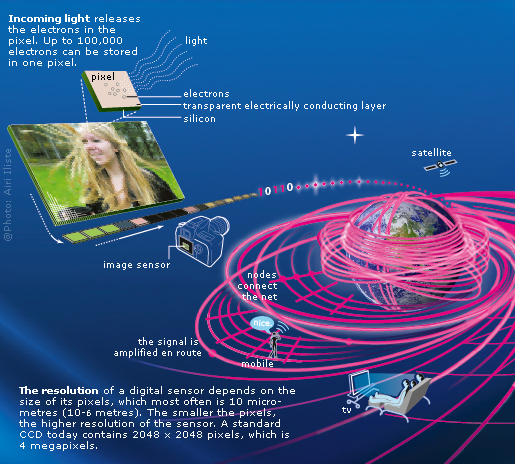
Half of the prize is awarded to Charles Kao who made a discovery that led to a breakthrough for fibre-optic communication. Today optical fibres make up the circulatory system that nourishes our information society. Light flows in threads of glass, as thin as a hair, which carries almost all of the telephony and data traffic in each and every direction. Without optical fibres there would be no internet nor broadband. A large share of the traffic is made up of digital images, which constitute the second part of the award. In 1969 Willard S. Boyle and George E. Smith invented the first successful imaging technology using a digital sensor, a CCD (Charge-Coupled Device). The CCD revolutionized photography, as light could now be captured electronically instead of on film. The image sensor, CCD, is the advanced digital camera's electronic eye. Incoming light releases electrons in the CCD's photocells, the pixels. The more light, the more electrons are collected in The CCD array is read out row by row. Electrons slide off the array onto an electronic conveyor belt and are subsequently translated into digital ones and zeros. This digital form makes it easy to manipulate and transfer the images. Every pixel is a silicon mini-capacitor built in layers that collects the electrons. A variable electric voltage is used for reading out the pixels. In this simple but ingenious way, almost the entire area of the sensor is used to collect light, creating the high performance of the CCD.
Original notes. During a short brainstorm meeting on September 8, 1969 (according to the notes), Willard Boyle and George Smith made the first sketch of a CCD. Photography was not what they had in mind, but very soon CCD became the first truly successful technology for the digital recording of images. |
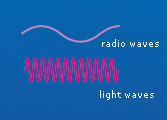 |
Compared to radio waves, light carries tens of thousands times more information because of its much higher frequencies. But ways to transmit light signals over longer distances were still not known in the first half of the 1960's. After just 20 metres, only 1 percent of the light that had entered a glass fibre remained. Reducing this loss of light became a challenge for a visionary like Charles Kao. |
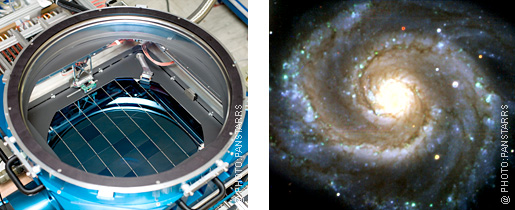
Early on, astronomers realized the advantages of the digital image sensor. It spans the entire light spectrum, from X-ray to infrared. It is a much more sensitive than photographic film: out of 100 incoming light particles, CCD catches up to 90, whereas photographic film will only catch one.
Left: the world's largest digital camera ever, built at the University of Hawaii. Its 40 square centimetres surface contains 64 x 64 CCDs, 1.4 billion pixels in total. Astronomers hope that telescopes equipped with such cameras will find 5,000 new supernovas as well as detect asteroids in potentially threatening trajectories towards Earth.
Right: spiral galaxy M51 in the constellation Canes Venatici is one of the first images taken with this digital camera.
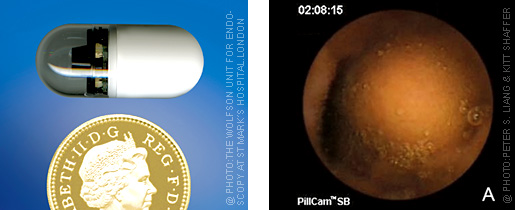
Medicine. CCD technology is used in a host of medical applications, e.g. imaging the inside of the human body, both for surgical operations and for diagnostics such as endoscopy.
Left: endoscopy capsule carrying a digital camera and a radio transmitter. Once swallowed by the patient, the capsule wanders along the digestion system and sends images like this from a 21 year old woman with cancer of the small intestine, right.
Source:
http://www.nobelprize.org/nobel_prizes/physics/laureates/2009/
1 2 3 4 5 6 7 8 9 10 Newest articles
|
Sub quantum space and interactions from photon to fermions and bosons |
Interesting articles
Since 1962 I doubted on Newton's laws. I did not accept the infinitive speed and I found un-vivid the laws of gravity and time.
I learned the Einstein's Relativity, thus I found some answers for my questions. But, I had another doubt of Infinitive Mass-Energy. And I wanted to know why light has stable speed?
